Warehouse Lease Agreement Samples
-
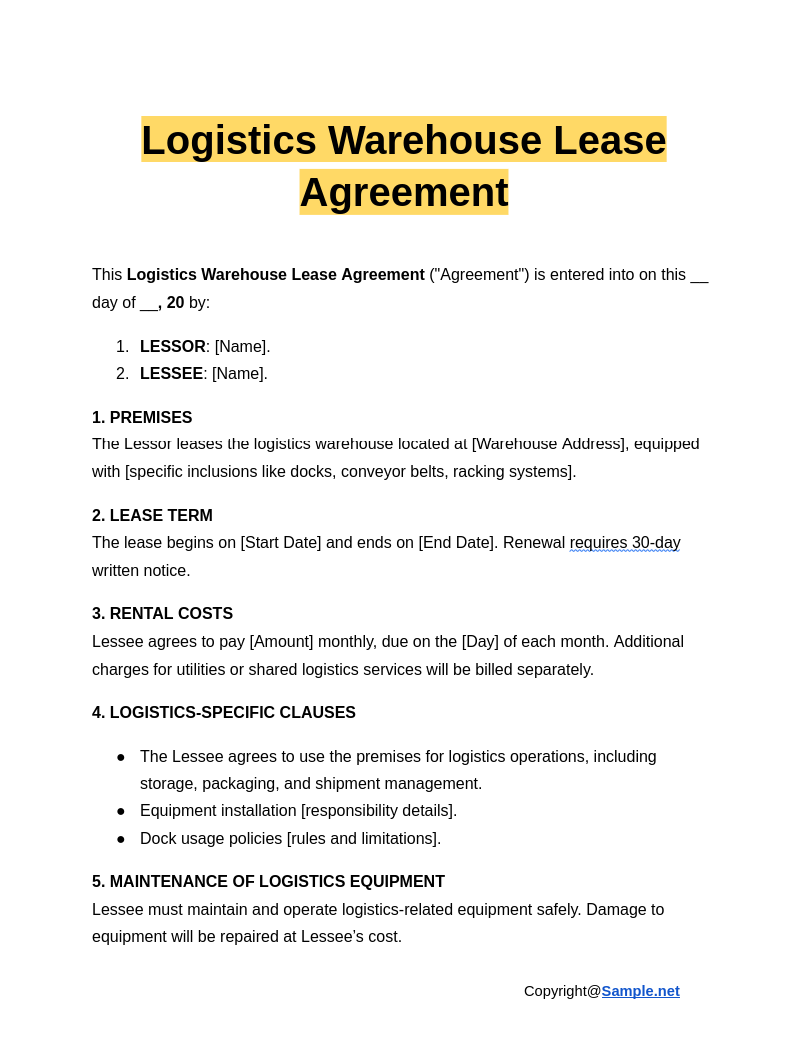
Logistics Warehouse Lease Agreement
download now -
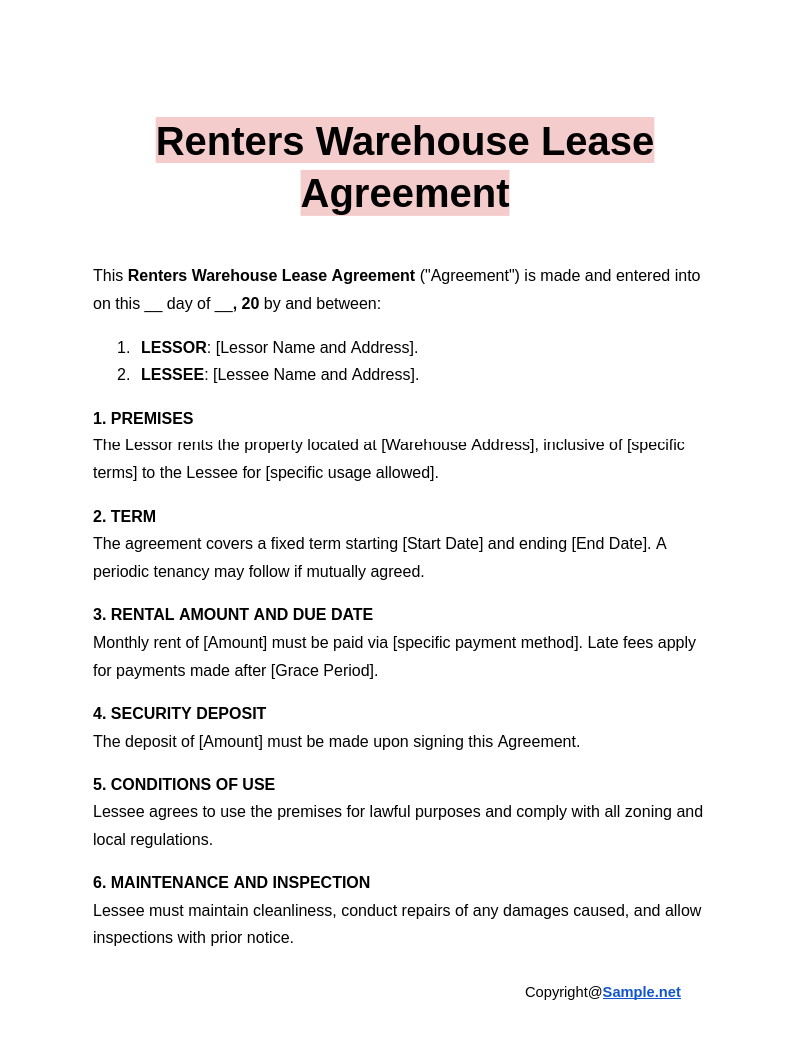
Renters Warehouse Lease Agreement
download now -
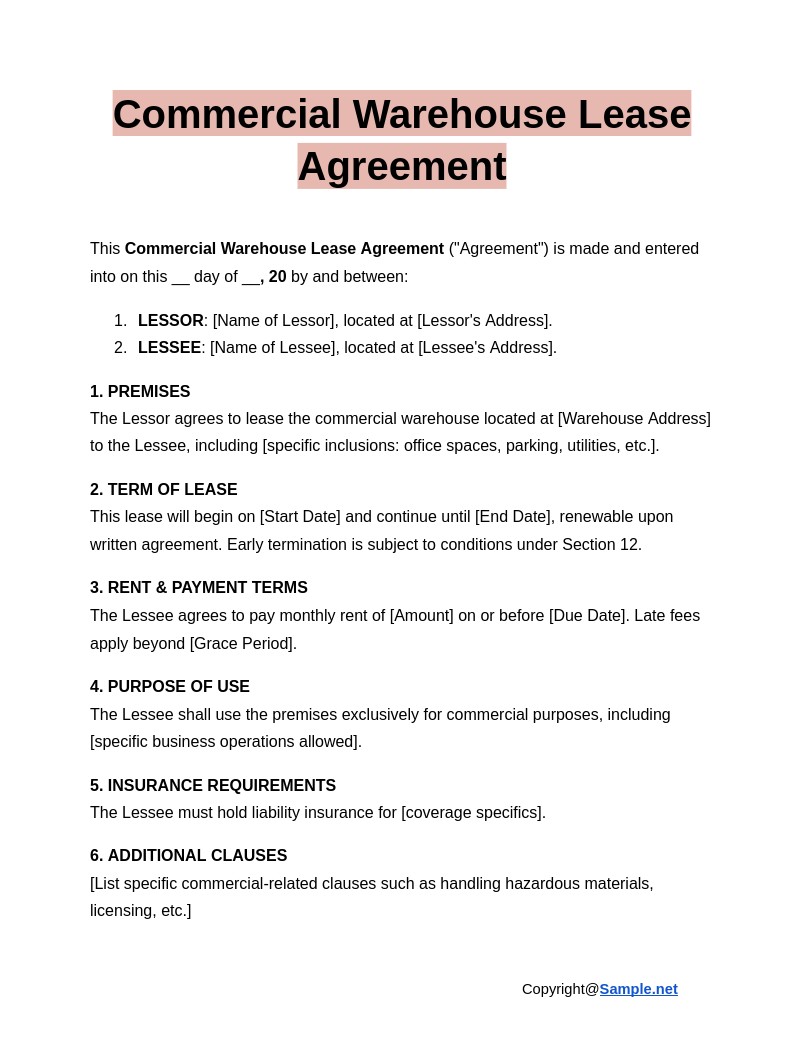
Commercial Warehouse Lease Agreement
download now -
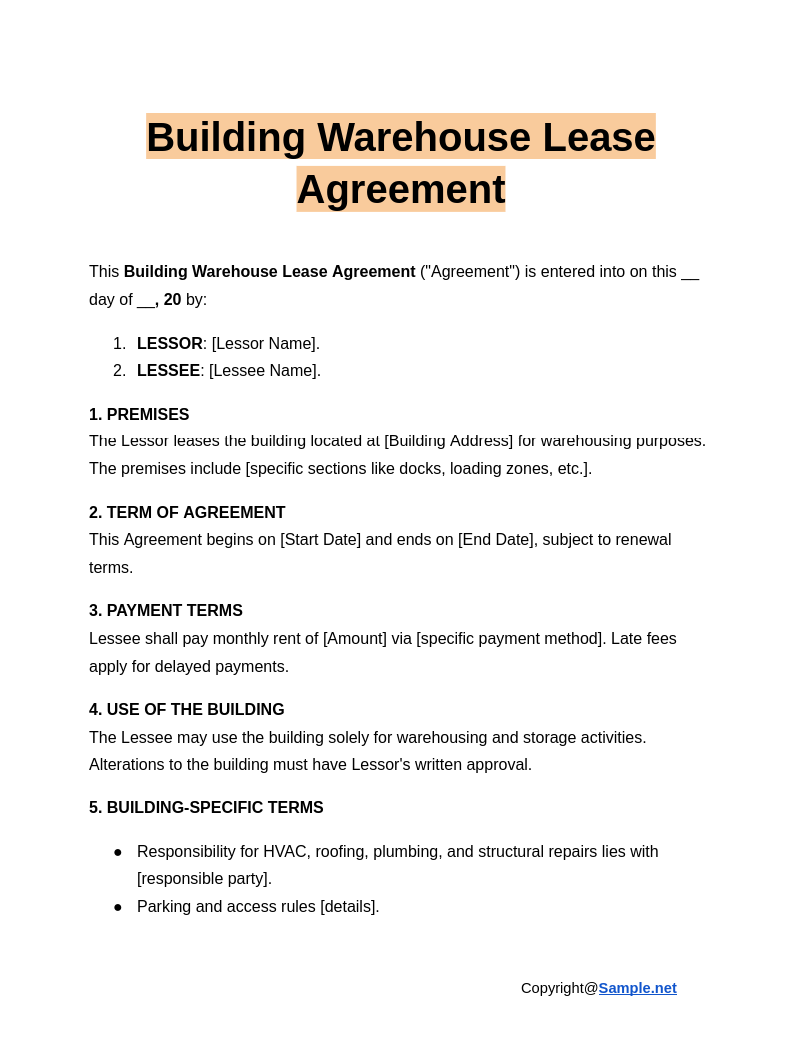
Building Warehouse Lease Agreement
download now -
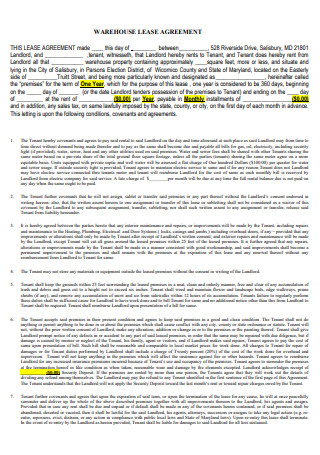
Warehouse Lease Agreement Template
download now -
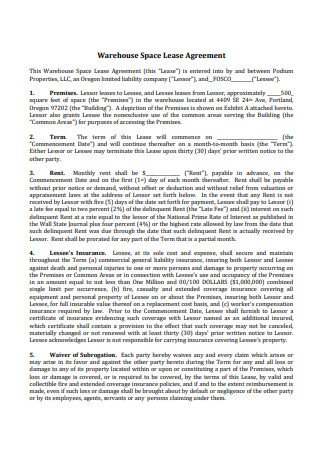
Warehouse Space Lease Agreement
download now -
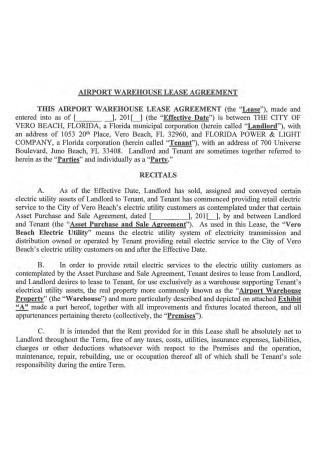
Airport Warehouse Lease Agreement
download now -
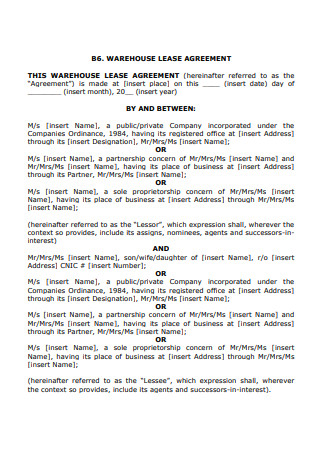
Warehouse Lease Agreement Example
download now -
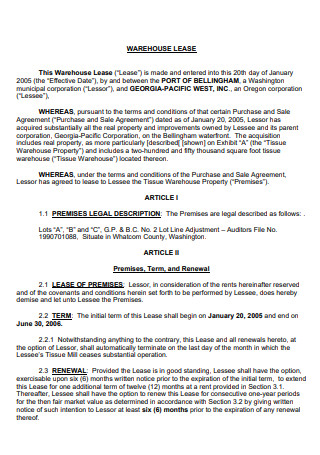
Warehouse Lease Agreement in PDF
download now -
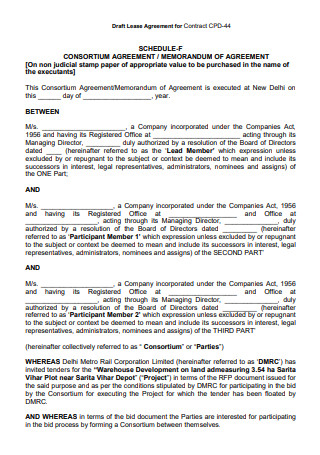
Draft Warehouse Lease Agreement
download now -
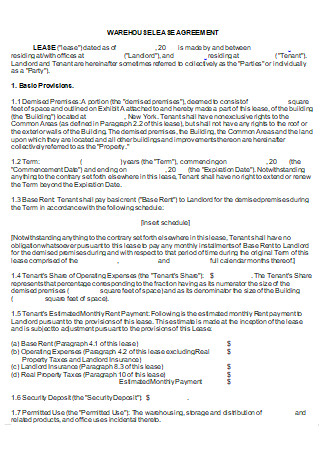
Warehouse Lease Agreement in DOC
download now
FREE Warehouse Lease Agreement s to Download
Warehouse Lease Agreement Format
Warehouse Lease Agreement Samples
What is a Warehouse Lease Agreement?
Elements of a Warehouse Lease Agreement
How to Create a Warehouse Lease Agreement
FAQs
How much is the lease for a warehouse?
Where is the best city to have a warehouse?
What key details should be included in a Warehouse Lease Agreement?
What are the common restrictions in warehouse lease agreements?
How can tenants ensure compliance with warehouse lease terms?
What happens if the tenant fails to pay rent on time?
What insurance is typically required in a Warehouse Lease Agreement?
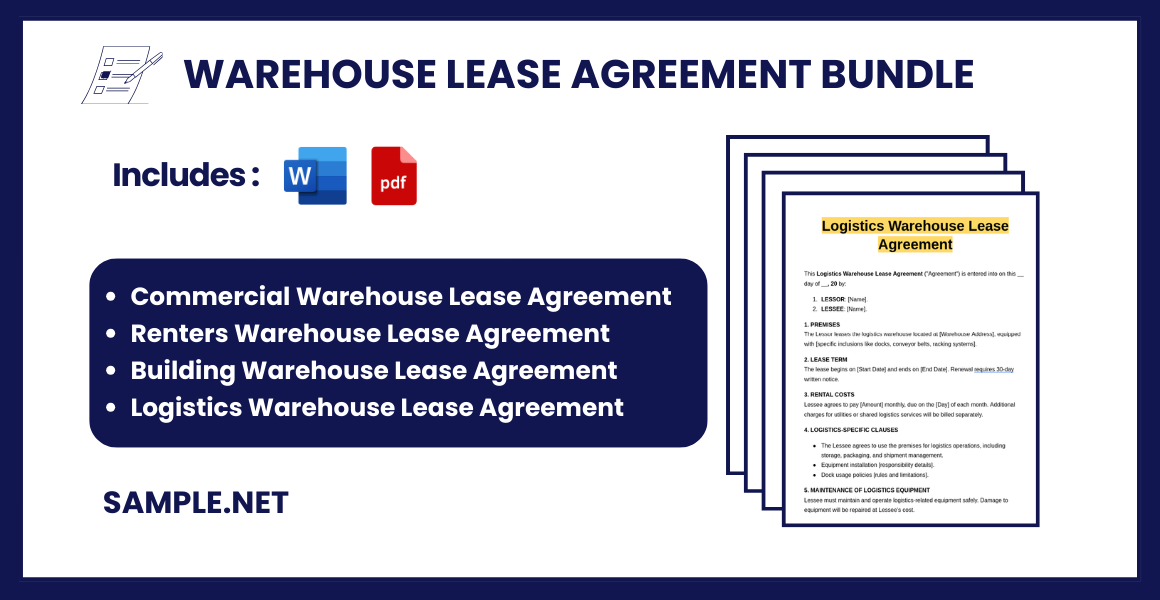
Download Warehouse Lease Agreement Bundle
Warehouse Lease Agreement Format
This Warehouse Lease Agreement (“Agreement”) is made and entered into on this __ day of __, 20 by and between:
- LESSOR: [Name of Lessor], having its address at [Lessor’s Address].
- LESSEE: [Name of Lessee], having its address at [Lessee’s Address].
The Lessor and Lessee may hereinafter be referred to collectively as the “Parties” and individually as a “Party.”
1. PREMISES
The Lessor agrees to lease to the Lessee the warehouse located at [Full Address of the Warehouse] (the “Premises”) including [specific inclusions such as office space, parking, or loading docks].
2. TERM OF THE AGREEMENT
The term of this lease shall commence on [Start Date] and continue until [End Date], unless terminated earlier in accordance with the terms of this Agreement. The Agreement may be renewed upon mutual written agreement of both parties.
3. RENT AND PAYMENT TERMS
- Monthly Rent: The Lessee shall pay the Lessor a monthly rent of [Amount] payable in advance on or before the [Due Date] of each month.
- Payment Method: Payments shall be made via [specify method: bank transfer, cheque, etc.] to the Lessor’s designated account at [Bank Details, if applicable].
- Late Payment: A late fee of [Percentage/Amount] shall apply for payments not received within [Grace Period] days.
4. SECURITY DEPOSIT
The Lessee shall deposit a refundable security amount of [Amount] with the Lessor, which will be held against damages or unpaid dues. The deposit shall be refunded within [timeframe] after the termination of the lease, less any deductions for damages or dues.
5. USE OF PREMISES
- The Lessee shall use the warehouse solely for [state purpose, e.g., storage of goods] and comply with all local laws, zoning ordinances, and regulations.
- The Lessee shall not use the premises for any illegal or hazardous activities.
6. MAINTENANCE AND REPAIRS
- The Lessee shall maintain the premises in good condition and perform routine maintenance.
- The Lessor shall be responsible for structural repairs and repairs due to normal wear and tear.
- Any damages caused by the Lessee or their employees shall be repaired at the Lessee’s expense.
7. ALTERATIONS
The Lessee shall not make any alterations, modifications, or improvements to the premises without prior written consent from the Lessor.
8. INSURANCE
The Lessee shall obtain and maintain adequate insurance coverage for [state required coverage, e.g., property damage, liability]. Proof of insurance shall be provided to the Lessor upon request.
9. UTILITIES
The Lessee shall bear the cost of all utilities, including but not limited to electricity, water, and internet services used on the premises.
10. ACCESS AND INSPECTION
The Lessor shall have the right to access the premises with prior notice for inspection, repairs, or showing the premises to prospective tenants or buyers.
11. INDEMNIFICATION
The Lessee agrees to indemnify and hold harmless the Lessor from any claims, liabilities, or damages arising out of the Lessee’s use of the premises.
12. TERMINATION
- Either party may terminate this Agreement with a [Number]-day written notice.
- Upon termination, the Lessee shall vacate the premises, remove all property, and return the premises in its original condition (except for normal wear and tear).
13. GOVERNING LAW
This Agreement shall be governed by and construed in accordance with the laws of [State/Country].
14. ENTIRE AGREEMENT
This Agreement constitutes the entire understanding between the Parties and supersedes all prior agreements, representations, or understandings.
15. ADDITIONAL TERMS AND CONDITIONS
[List any additional clauses or terms as necessary, e.g., penalties, specific restrictions.]
IN WITNESS WHEREOF, the parties hereto have executed this Warehouse Lease Agreement as of the date first written above.
LESSOR:
Name: ______________________________
Signature: __________________________
Date: ______________________________
LESSEE:
Name: ______________________________
Signature: __________________________
Date: ______________________________
WITNESS 1:
Name: ______________________________
Signature: __________________________
Date: ______________________________
WITNESS 2:
Name: ______________________________
Signature: __________________________
Date: ______________________________
What is a Warehouse Lease Agreement?
A warehouse lease agreement is a document that has the concord of a landlord who owns a warehouse and a tenant who will rent the warehouse. Some manufacturers have no place for storage that they need a commercial space that can sustain their needs. They will enter a storage agreement that will enable them to use the warehouse of the landlord or lessor. Being a lessee means that manufacturers should adhere to the terms of the lease. Any sample contract has its own rules that the lessee should comply with. Storage rental is much needed by manufacturers because they have products that need a place to be stored. So this agreement is needed by entrepreneurs.
Elements of a Warehouse Lease Agreement
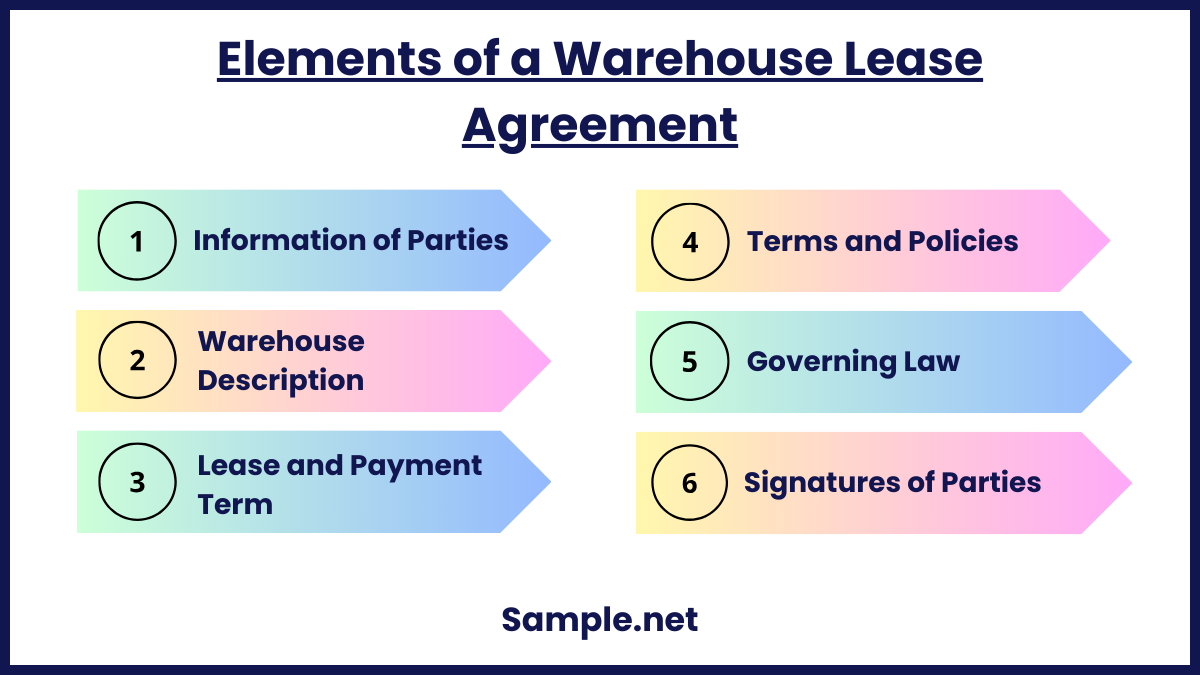
Maybe you are being choosy with warehouse agreement format or commercial rental agreement format. If you want the best in creating your warehouse rental agreement, you must ensure that you can put all its elements to make it complete. Read the following and know some of the elements of a warehouse lease agreement:
How to Create a Warehouse Lease Agreement
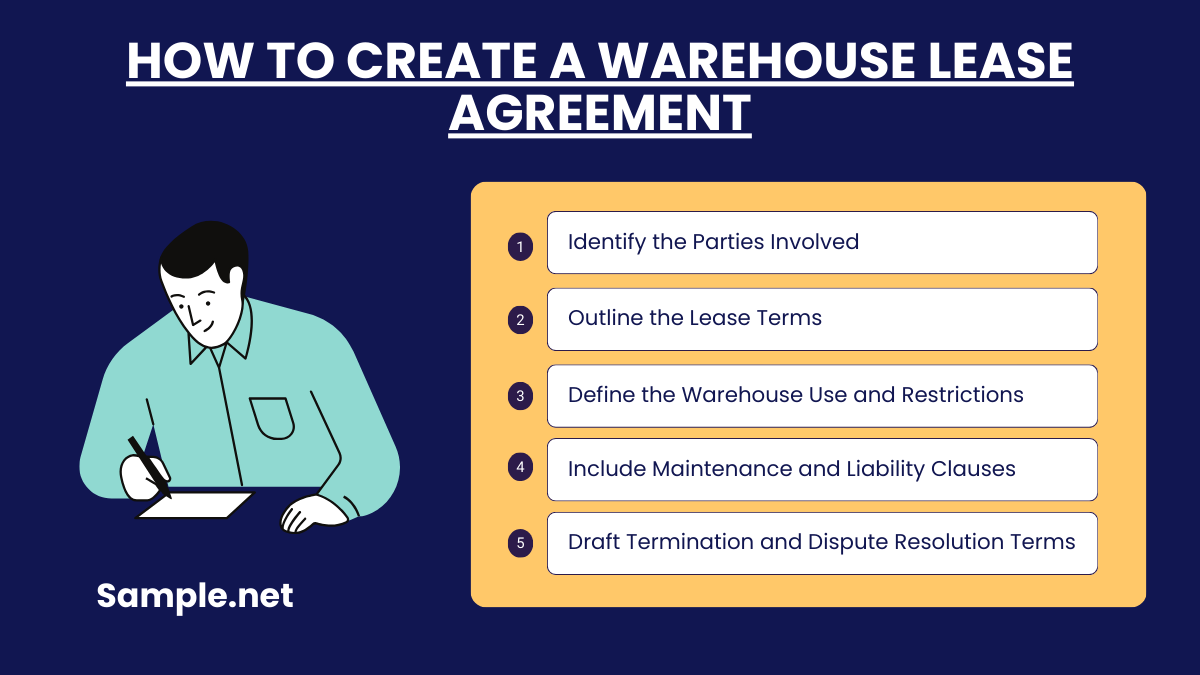
1. Identify the Parties Involved
Start by clearly identifying the landlord and tenant, including their full legal names and contact details. This ensures that the agreement is enforceable and leaves no ambiguity about the parties responsible for fulfilling the lease obligations. Accurate identification establishes a solid legal foundation.
2. Outline the Lease Terms
Specify the lease duration, whether it’s short-term or long-term, and the start and end dates. Include options for renewal or early termination, along with associated conditions. Clearly define rent payment details, including the due date, payment methods, and penalties for late payments. This step ensures transparency.
3. Define the Warehouse Use and Restrictions
Detail the purpose of the warehouse, such as storage, distribution, or manufacturing. Include any restrictions, like the prohibition of hazardous materials or alterations without approval. Defining these terms avoids misuse of the property and ensures compliance with zoning laws.
4. Include Maintenance and Liability Clauses
Outline responsibilities for maintenance, repairs, and utilities. Specify who handles property taxes, insurance, and upgrades. Address liability issues, including damage caused by negligence, and ensure the tenant agrees to indemnify the landlord for legal claims related to warehouse use.
5. Draft Termination and Dispute Resolution Terms
Establish clear rules for lease termination, including notice periods and penalties for breaches. Include dispute resolution mechanisms, such as mediation or arbitration, to handle conflicts. This ensures a smooth exit process and minimizes legal disputes between the parties.
FAQs
How much is the lease for a warehouse?
The price of the lease of a warehouse depends on the location of the warehouse and its features. The average lease for a warehouse is $0.85 – $25 per square foot per month.
Where is the best city to have a warehouse?
Atlanta, Georgia is the best city where you can have your warehouse. It has the busiest airports in the world so you can be sure that you can have your supplies earlier and can deliver your products better.
What key details should be included in a Warehouse Lease Agreement?
Essential details include the names of the parties involved, lease duration, rent amount, payment terms, and permitted usage. Additionally, the agreement should specify responsibilities for maintenance, property taxes, and insurance. Including clauses on renewal options and dispute resolution adds clarity and reduces potential conflicts during the lease term.
What are the common restrictions in warehouse lease agreements?
Restrictions may include prohibiting the storage of hazardous materials, requiring approval for structural modifications, or limiting the types of business activities conducted on-site. These restrictions protect the landlord’s property and ensure compliance with safety and zoning regulations. Tenants should review restrictions before signing.
How can tenants ensure compliance with warehouse lease terms?
Tenants should familiarize themselves with the lease agreement and adhere to its terms, such as paying rent on time, maintaining the property, and using the warehouse as specified. Regular communication with the landlord and addressing concerns promptly further ensures compliance.
What happens if the tenant fails to pay rent on time?
The agreement often includes penalties for late payments, such as additional fees or interest charges. Persistent non-payment can lead to lease termination or legal action by the landlord. Tenants should address financial issues early to avoid consequences.
What insurance is typically required in a Warehouse Lease Agreement?
Tenants are usually required to have liability insurance to cover damages or injuries related to their operations. Property insurance may also be necessary to protect stored goods. The agreement may specify minimum coverage requirements to protect both parties.
